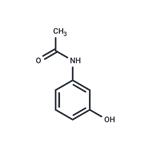- Metacetamol
-

- $29.00 / 50mg
-
2024-11-19
- CAS:621-42-1
- Min. Order:
- Purity: 99.72%
- Supply Ability: 10g
- Metacetamol
-

- $29.00 / 50mg
-
2024-11-19
- CAS:621-42-1
- Min. Order:
- Purity: 99.72%
- Supply Ability: 10g
- 3-ACETAMIDOPHENOL
-

- $15.00 / 1KG
-
2021-08-11
- CAS:621-42-1
- Min. Order: 1KG
- Purity: 99%+ HPLC
- Supply Ability: Monthly supply of 1 ton
|
| | 3-ACETAMIDOPHENOL Basic information |
| | 3-ACETAMIDOPHENOL Chemical Properties |
| Melting point | 145-148 °C(lit.) | | Boiling point | 273.17°C (rough estimate) | | density | 1.249 | | refractive index | 1.5810 (estimate) | | storage temp. | Keep in dark place,Inert atmosphere,Room temperature | | solubility | Chloroform (Slightly), DMSO (Slightly), Methanol | | pka | 9.50±0.10(Predicted) | | form | Crystals, Crystalline Powder or Needles | | color | Off-white to tan or light gray | | PH | 6-7 (H2O)(saturated solution) | | BRN | 907998 | | CAS DataBase Reference | 621-42-1(CAS DataBase Reference) | | EPA Substance Registry System | 3'-Hydroxyacetanilide (621-42-1) |
| Hazard Codes | Xi,Xn | | Risk Statements | 36/37/38 | | Safety Statements | 26-36 | | RIDADR | 2811 | | WGK Germany | 2 | | RTECS | AE4100000 | | F | 1-8 | | Hazard Note | Irritant | | TSCA | Yes | | HazardClass | 6.1(b) | | PackingGroup | III | | HS Code | 29242995 | | Toxicity | LD50 intraperitoneal in mouse: 1025mg/kg |
| | 3-ACETAMIDOPHENOL Usage And Synthesis |
| Chemical Properties | off-white to tan or light grey crystals, | | Uses | 3-Acetamidophenol is the ortho-regioisomer of Acetaminophen (A161220), an over-the-counter analgesic and antipyretic agent (1,2). | | Definition | ChEBI: A derivative of phenol which has an acetamido substituent located meta to the phenolic -OH group. It is a non-toxic regioisomer of paracetamol with analgesic properties, but has never been marketed as a drug. | | General Description | Light gray solid. | | Air & Water Reactions | Water insoluble. | | Reactivity Profile | Phenols do not behave as organic alcohols, as one might guess from the presence of a hydroxyl (-OH) group in their structure. Instead, they react as weak organic acids. Phenols and cresols are much weaker as acids than common carboxylic acids (phenol has Ka = 1.3 x 10^[-10]). These materials are incompatible with strong reducing substances such as hydrides, nitrides, alkali metals, and sulfides. Flammable gas (H2) is often generated, and the heat of the reaction may ignite the gas. Heat is also generated by the acid-base reaction between phenols and bases. Phenols are sulfonated very readily (for example, by concentrated sulfuric acid at room temperature). The reactions generate heat. Phenols are also nitrated very rapidly, even by dilute nitric acid. Nitrated phenols often explode when heated. Many of them form metal salts that tend toward detonation by rather mild shock. Flammable gases are formed by the reaction of organic amides with strong reducing agents. Amides are very weak bases (weaker than water). Mixing amides with dehydrating agents such as P2O5 or SOCl2 generates the corresponding nitrile. The combustion of these compounds generates mixed oxides of nitrogen (NOx). | | Fire Hazard | Flash point data for 3-ACETAMIDOPHENOL are not available. 3-ACETAMIDOPHENOL is probably combustible. | | Purification Methods | Recrystallise the phenol from water. The 3,5-dinitrobenzamide complex gives orange-yellow crystals from hot H2O and has m 212o. [Beilstein 13 H 415, 13 I 132, 13 II 213, 13 III 950, 13 IV 977.] |
| | 3-ACETAMIDOPHENOL Preparation Products And Raw materials |
|